Integrated circuit
An integrated circuit, also known as an integrated circuit (IC for short; the letters are pronounced individually: [ʔiː] [t͡seː] or obsolete IS) is an electronic circuit mounted on a thin wafer of semiconductor material, usually a few millimetres in size. It is sometimes also referred to as a solid-state circuit or monolithic integrated circuit. This chip (die) is usually encapsulated in a chip package several times larger for protection and ease of contacting. An IC typically contains a combination of numerous electrically interconnected electronic semiconductor components such as transistors, diodes and/or other active and passive components.
Integrated circuits today can comprise circuits with many billions of electronic components (especially transistors), so that even highly complex circuits such as microprocessors and memory chips can be accommodated on semiconductor wafers just a few square millimeters in size. Since the early 1990s, the microstructures of these elements have already been manufactured in the nanometer range. The rectangular semiconductor wafers are called chips (even in their raw state), and in particular together with the applied electronic circuit they are also called microchips. The production of ICs takes place in own semiconductor factories in absolutely dust-free clean rooms and includes a multitude of process steps of physical and chemical nature. Since the performance of microprocessors and memory chips generally increases as the structures on the chip become smaller, their miniaturization is often at the limits of what is technically and physically feasible. However, there are also numerous ICs, especially standardized ones, such as logic devices and operational amplifiers, where this plays only a minor role - for example, the logic chips of the widely used 74xx series, which has been manufactured since the 1970s, contain only a number of transistors in the one- or two-digit range.
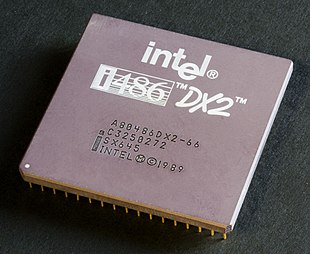
Unopened IC above: Below you can see a part of the 168 pins that are plugged into the processor socket on the motherboard of a PC during operation. Current processor chips now comprise about 4000 times as many transistors with similar dimensions.
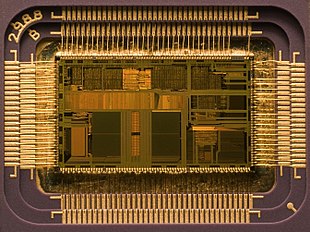
Microprocessor Intel i486DX2 (1992) : The opened case of the IC shows the 76 mm² semiconductor plate with 1.2 million transistors. The central rectangular area is the actual electronic circuit, with the leads for wiring to the pins of the package arranged on its sides. Functional units such as the processor's arithmetic unit and cache can be identified by different brightness levels.
Language
Colloquially, microchip or chip is now sometimes equated with an IC, although the chip only represents the "inner workings" of a circuit, i.e. the semiconductor chip with the actual circuit on it.
Also to be distinguished from integrated circuits are double, triple or other multiple components (whether semiconductor or tube), each of which is contained in a common package or glass bulb, such as double diodes, triodes, pentodes, double or triple Darlington transistors, etc.
History
See also: History, development and people of microelectronics
Predecessor
Before the development of integrated circuits, there were active electronic components that were hardwired together with several passive ones and shipped in one package. One example was the 3NF and 2HF electron or vacuum tubes developed in the mid-1920s - the former a triple tube similar to the later ECC83 double triode. Unlike the younger tube, however, both 1920s tubes had four or two resistors and two or one capacitor already incorporated inside the bulb of the tube, as in an IC. This resulted in ready-made radio circuits - the 3NF as basic circuit for local reception and amplification and the 2HF additionally for optional long-distance reception, where only the external components for station selection, power supplies and playback (loudspeakers or headphones) as well as the antenna had to be connected.
Until the end of the 1950s, electronic circuits were built with discrete components, i.e. with individual transistors, diodes, etc., which were assembled on a printed circuit board to form a circuit, cf. integration (technology). In terms of size and service life, this was already a significant breakthrough compared to the electron tubes that were competing at the time.
Even before the invention of the transistor, there were electronic components which integrated several functions in one component, in the form of multi-system tubes, composite tubes such as the 3NF, duodiodes or also multi-anode mercury vapour rectifiers which combined the function of several controlled or uncontrolled rectifiers (one cathode and several anodes) in one component. Transistors have significant advantages over vacuum tubes, such as lower power consumption and size. With the application of printed circuit boards or PCBs and the resulting downsizing of products, this newer technology began to displace the early tube-based integrated systems. This trend fully intensified with the development and massive use of integrated circuits beginning in the 1960s.
Jacobi patent
Little known is the "semiconductor amplifier", a circuit consisting of five transistors on a semiconductor serving as a carrier material, invented and patented by Werner Jacobi as early as 1949. These form a three-stage amplifier circuit in the form of an integrated circuit. Two transistors are connected "overhead" to effect impedance conversion between the transistor stages. Jacobi noted that this allows hearing aids, for example, to be made small, light and cheap.
An immediate commercial use of his patent is not known. The formulation of the integration idea in the patent specification published on May 15, 1952 reads: "Semiconductor amplifier, characterized in that several electrode systems acting in different switching or amplifier stages are placed on the semiconductor. Thus, for example, the integration of several light-emitting diodes in one housing goes back in its basic idea to Jacobi.
From Kilby and Noyce to today
The first integrated circuit (a flip-flop) was developed by Jack Kilby in September 1958. It consisted of two bipolar transistors mounted on a germanium substrate and connected by gold wires. This hybrid circuit is thus a first example of the implementation of the already known transistor-transistor logic (TTL) on a circuit. It was a preliminary stage for the further development of TTL circuits towards smaller designs.
Robert Noyce filed a patent application for the first "monolithic" integrated circuit, i.e. made from or in a single single-crystal substrate, in July 1959. The key feature of Noyce's invention was the complete fabrication of the components, including wiring, on a single substrate. The manufacturing process already used photolithographic techniques and diffusion processes that Fairchild Semiconductor had developed shortly before for the production of the first modern diffusion bipolar transistor. Based on these techniques, among others, the first microprocessors were introduced almost simultaneously by three companies in 1970/71: the Intel 4004, the Texas Instruments (TI) TMS 1000 and the Garrett AiResearch "Central Air Data Computer" (CADC).
The first integrated circuits in series production were created in the early 1960s (mainly by Texas Instruments and Fairchild Semiconductor). They consisted of up to a few dozen bipolar transistors (small-scale integration, SSI), typically in RTL technology. Over the years, however, the components became smaller and smaller, passive components such as resistors were integrated and the complexity of the integrated circuits increased. As a result, the number of transistors per chip or per unit area also increased; the number of transistors was the most important parameter of ICs.
A promoting factor for further development was the defense industry and space travel. Until the mid-1960s, the US government was the main customer for integrated circuits. The aim was to miniaturize the technology of both sectors. From 1965, the Gemini program was equipped with on-board computers based on ICs.
With medium-scale integration (MSI), a few hundred transistors found space on a chip, and with large-scale integration (LSI) at the beginning of the 1970s, a few thousand transistors. This made it possible for the first time to integrate an entire main processor (CPU) as a so-called microprocessor on a chip, which extremely reduced the costs for computers. At the beginning of the 1980s, this was followed by very-large-scale integration (VLSI) with several hundred thousand transistors, which soon made it possible to produce memory chips (RAM) with a capacity of 256 KiBit and 1 MiBit. This further development of manufacturing technology was accompanied by ever greater design automation (see chip design) of the design and the photomasks required for production, without which it was no longer possible to develop more complex circuits.
In 2010, graphics processors contained up to three billion transistors (see Nvidia Tesla), "normal" general-purpose CPUs up to 1.17 billion transistors (Intel Core i7-980X). The Itanium 2 Tukwila consists of 2.05 billion transistors. Meanwhile, graphics processors have reached transistor counts of over eight billion transistors (Nvidia GTX TitanX). Even larger numbers are reached with memory components, but with less complexity of the entire chip.
· 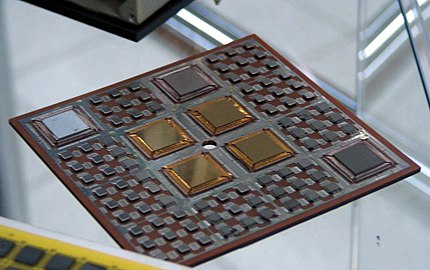
Miscellaneous ICs
· 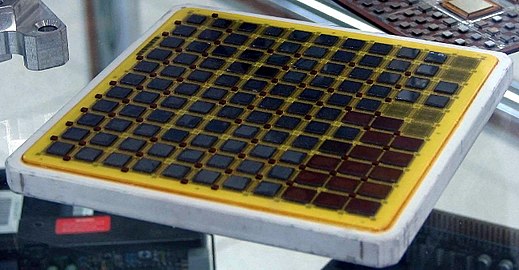
ICs on TCM ceramic carrier from an IBM mainframe
· 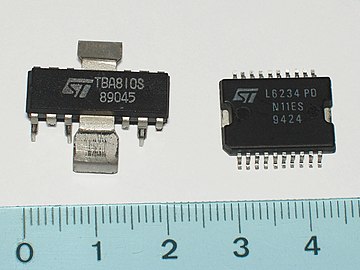
ICs in plastic housing
· 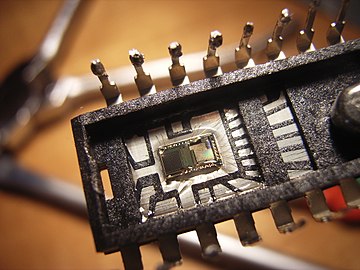
ICs in chip package with leads

Detailed view of an EPROM. The bonded connection wires can be seen well
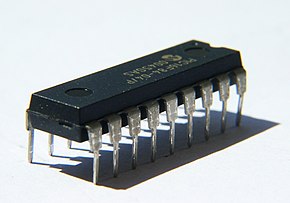
IC in DIP plastic housing. Older 8-bit microcontroller (PIC 16F84A) with writable EEPROM memory. The integrated circuit is not visible inside the plastic housing.

Replica of the first IC by Jack Kilby. Model in the Heinz Nixdorf MuseumsForum
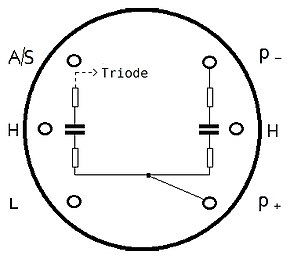
Circuit of the integrated resistors and capacitors inside the 3NF by Siegmund Loewe (patent 1925/1926). Contacts → * Triode: to the inner triode * A/S: outside to the antenna and station selection * P: outside to the battery (P=Power) * H: outside to the voltage for the tube heating * L: outside to the loudspeaker or headphones.
Questions and Answers
Q: What is an integrated circuit?
A: An integrated circuit, also known as an IC or microchip, is a piece of specially prepared silicon on which an electronic circuit is etched using photolithography.
Q: What are some examples of devices that can be included on a silicon chip?
A: Silicon chips can contain logic gates, computer processors, memory, and special devices.
Q: Why is a plastic package used to surround the chip?
A: The chip is very fragile, so a plastic package is used to protect it.
Q: How is electrical contact made with the chip?
A: Electrical contact with the chip is provided through tiny wires that connect the chip to larger metal pins that stick out of the package.
Q: What are two advantages of using ICs instead of discrete circuits?
A: ICs have two main advantages over discrete circuits: cost and performance. Cost is low because millions of transistors can be put onto one chip instead of building a circuit with single transistors. Performance is higher since the components can operate more quickly and use less power.
Q: What are the different types of ICs?
A: Integrated circuits can be classified into analog, digital and mixed signal (both analog and digital on the same chip).
Q: Can a single chip be designed for a specific purpose?
A: Yes, a chip may be designed for a specific purpose, such as a calculator chip that can only work as a calculator.
Search within the encyclopedia